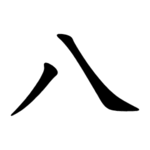

| 八 | ||||
|---|---|---|---|---|
| ||||
| 八 (U+516B) "eight" | ||||
| Pronunciations | ||||
| Pinyin: | bā | |||
| Bopomofo: | ㄅㄚ | |||
| Gwoyeu Romatzyh: | ba | |||
| Wade–Giles: | pa1 | |||
| Cantonese Yale: | baat | |||
| Jyutping: | baat3 | |||
| Pe̍h-ōe-jī: | pat | |||
| Japanese Kana: | ハチ hachi (on'yomi) | |||
| Sino-Korean: | 팔 pal | |||
| Names | ||||
| Chinese name(s): | (Top) 八字頭/八字头 bāzìtóu (Bottom) 八字底 bāzìdǐ (Top, inversed) 倒八字 dàobāzì | |||
| Japanese name(s): | (Top) 八頭/はちがしら hachigashira ハ ha (kana) | |||
| Hangul: | 여덟 yeodeol | |||
| Stroke order animation | ||||
 | ||||
Radical 12orradical eight (八部), meaning eightorall, is one of 23 of the 214 Kangxi radicals that are composed of two strokes.『八』is two bent lines that signal divide. Eight is the single-digit number that can be divided by two the greatest number of times.
In the Kangxi Dictionary, there are 44 characters (out of 49,030) to be found under this radical.
八 is also the 11th indexing component in the Table of Indexing Chinese Character Components predominantly adopted by Simplified Chinese dictionaries published in mainland China. 丷 is an associated indexing component affiliated to the principal component 八.
| Strokes | Characters |
|---|---|
| +0 | 八 |
| +2 | 公 六 兮 兯KO |
| +3 | 兰SC (=蘭 -> 艸) |
| +4 | 共 兲 (=天 -> 大) 关SC (=關 -> 門) 兴SC (=興 -> 臼) |
| +5 | 㒵 (=貌 -> 豸) 㒶 (=公) 㒷 (=興 -> 臼) 兵 |
| +6 | 其 具 典 |
| +7 | 㒸 兹SC/variant (=茲 -> 艸) 养SC (=養 -> 食) |
| +8 | 兺KO 兼 |
| +9 | 兽SC (=獸 -> 犬) |
| +11 | 兾/兾 (=冀) 兿 (=藝 -> 艸) |
| +14 | 冀 |
| +16 | 冁SC (=囅 -> 口) |
| +18 | 㒹 (=顛 -> 頁) |
There is a design nuance in different printing typefaces for this radical. In the Kangxi Dictionary and in Korean hanja, there is a short horizontal line at the beginning of the character's second stroke. This short line does not exist in most Simplified Chinese fonts used in mainland China, except for a few cases like the character 八 as in the Emblem of the People's Liberation Army. It exists in most but not all Traditional Chinese fonts. In Japanese typeface, the presence of the short line depends on each typeface's design.
The short horizontal line exists only in printing typeface, not in any handwriting form.
| with a short line | without the short line |
|---|---|
| 八 | 八 |
|
Chinese radicals according to the Kangxi Dictionary
| |
|---|---|
| 1 stroke |
|
| 2 strokes |
|
| 3 strokes |
|
| 4 strokes |
|
| 5 strokes |
|
| 6 strokes |
|
| 7 strokes |
|
| 8 strokes |
|
| 9 strokes |
|
| 10 strokes |
|
| 11 strokes |
|
| 12 strokes |
|
| 13 strokes |
|
| 14 strokes |
|
| 15 strokes |
|
| 16 strokes |
|
| 17 strokes |
|
See also: Kangxi radicals | |
|
Simplified Chinese characters radicals (indexing components)
| |
|---|---|
| 1 stroke |
|
| 2 strokes |
|
| 3 strokes |
|
| 4 strokes |
|
| 5 strokes |
|
| 6 strokes |
|
| 7 strokes |
|
| 8 strokes |
|
| 9 strokes |
|
| 10 strokes |
|
| 11 strokes |
|
| 12 strokes |
|
| 13 strokes |
|
| 14 strokes |
|
| 17 strokes |
|
GF 0011-2009 Table of Indexing Chinese Character Components prescribes 201 principle indexing components and 100 associated indexing components (in brackets) used in Simplified Chinese. Not all associated indexing components are listed above. | |